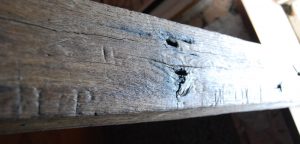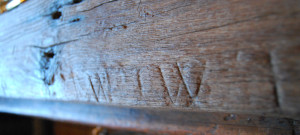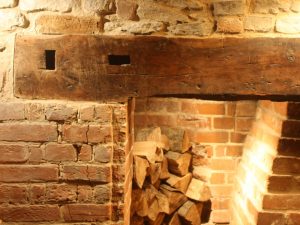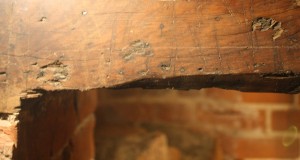No products in the basket.
29th October 2013
Here be Witchcraft
We had a customer here on Saturday wanting an oak beam for his fireplace lintel. We try and keep a selection of them in stock – salvaged, prepped up and ready to sell. It was only when placing one of the beams aside we happened to put it down with daylight glancing along its length and we spotted that it held a secret. It was covered in apotropaic markings.
Here be witchcraft.
On its first installation as a fireplace lintel, probably in the 16th or 17th Century – and as a continuing practice thereafter – this beam was marked with certain small cuts, symbols, letters, notches and burns along its length. Marks for the warding-off of evil, banishing the evil eye. So, more accurately: here be counter witchcraft!

From around 1550 to 1750 apotropaic markings are thought to have been widespread. In an age when the Church was in turmoil and printing was in its infancy – local, superstitious, hocus-pocus belief systems were deeply entrenched. Rural life was thick with measures to keep evil at bay. Then “Witches” were being tried, often involving ducking or weighing, and ultimately, tragically, “cured” through barbarous means … or burned.
At home, it was thought that with doors barred and windows shuttered – variously against the cold and the intruders and the evil – that the chimney, open to the sky, was vulnerable – particularly for incursions of the evil. Witches, you see, could turn themselves into birds or bats. Even James I included the subject in his 1597 treatise “Daemonologie”,
“For some of them sayeth that being transformed in the likeness of a little beast or fowl, they will come and pierce through, whatever house or church, though all ordinary passages be closed, by whatsoever open(ing) the air may enter in at.”
You can pick up remnants of these occult superstitions even today whether it be in nailed-up horse-shoes, genuflections to magpies, vampire stories (n.b their trouble with thresholds), or, dare I say it, Father Christmas himself.
If you live in a timber-framed house dating back earlier than the eighteenth century look out for scratchings on the bressumer beam, sometimes only very lightly inscribed at the top corners of the fireplace, like the scratching of a cat. Look for a repeated “W” – thought to be a double “V” for “Virgo Virginum”. Look for daisy wheels – a circular device with petals, or runic symbols – a “P” incorporating a cross, or a “W” incorporating a “P”. Look for two verticals with a “Saltire” cross between them – a motif also much used on iron door latches and bolts and wrought iron firedogs (St Andrew was considered the best hex against witches particularly in Northern England and Scotland).

These “Marian” marks and symbols are generally found incised into timbers with a race-knife but were also painted onto plaster – not much of which survives. You’ll find small burns, thought to inoculate the timber against fire. No one today seems entirely sure what the precise meanings are. From the attics of Kew Palace through to cave systems in Gloucestershire, and remarkably even despite The Reformation, these same marks were widely used across the country. There is an example in Great Milton – a stone’s throw from LASSCO Three Pigeons.


It wasn’t just markings either. Desiccated cats are found in chimneys (intentionally placed there post-mortem). A single shoe or boot was often incorporated into thatch. Phials of urine are discovered, sometimes with iron pins enclosed, buried under the hearth. Rowan trees were planted near the door.
And these beliefs travelled: apotropaic marks are found in the timber houses of New World settlers in America and Australia.
If you would like to keep the evil spirits away this Halloween, the apotropaic beam we’ve discovered is available at LASSCO Three Pigeons, cleaned, oiled and all prepped up against evil too (fingers crossed).
Anthony Reeve
LASSCO Three Pigeons
Thanks to Mr N.Herbert & Ms. S.Read of Great Milton for allowing my evil incursion to photograph their fireplace.
Some Further Reading:
Easton T. 1999. “Ritual Marks on Historic Timber” Weald & Downland Museum Magazine. Spring Edition, pp22-28
James I [Stuart] 1597. “Daemonologie”. Reprinted 1922 by The Bodley Head and 1998 by Godolphin House
Kennedy M. 2004. “Scare witch project. Repairs at Kew Palace uncover a tradition of superstition”. The Guardian, Thursday April 29, p.13
